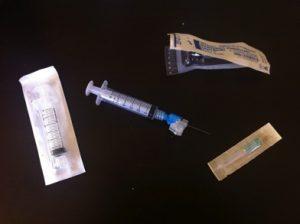By: Rebecca Lowe
Syringe exchange programs are private or government funded programs that provide clean syringes to people who do not have prescriptions. Organizations like Centers for Harm and Prevention adopt these syringe exchange programs, usually in inner cities, to give injection drug users access to untainted needles. The benefit of these programs is that they significantly reduce the risk of spreading hematogenous diseases, such as HIV/AIDS and Hepatitis B and C, by preventing people from sharing dirty needles. A common misconception is that these programs encourage more people to use drugs because of the decreased risk of contracting diseases spread through blood contact. Because of their association with intravenous drug use, these programs have become extremely controversial.
According to John K. Watters, et al in Syringe and Needle Exchange as HIV/AIDS Prevention for Injection Drug Users, a study shows that 24% of people with AIDS contracted it by using dirty syringes. In addition, tens of thousands more contracted AIDS from having sexual relations with an injection drug user. Thus, preventing dirty needle sharing protects not just injection drug users but their partners as well. With the adoption of syringe exchange programs, many questions arise such as: are these programs effective in reducing the spread of HIV/AIDS and Hepatitis B and C? Are they cost effective for society? Do they encourage illegal drug use? Are syringe exchange programs legalized in the United States?
In comparison to other public health programs, syringe exchange programs have received substantially more criticism. For example, another public health program that serves to reduce HIV/AIDS and Hepatitis B and C is the distribution of condoms to high school teenagers. This act is done all throughout the country and could be considered as encouragement for minors to engage in sexual intercourse. While syringe exchange programs have a higher shock value, they parallel the underlying goal of health promotion and should also be considered a benefit to the community. To address the question of whether or not syringe exchange programs encourage injection drug use, a study of 996 injection drug users by Dr. van Ameijden shows that syringe exchange programs actually reduce the amount of injection drug users. Further, the amount of injection drug users under the age of 22 had reduced drastically during the mid 1980’s.
In terms of cost-effectiveness for society, the community would actually be saving money by instituting syringe exchange programs by not having to pay the hospital bills of the infected users — who are disproportionately poor and unable to afford health insurance in the first place. One research study examined in Cost-Effectiveness of Syringe Exchange as an HIV Prevention Strategy shows that is was cost efficient in the state of New York to provide syringe exchange programs, indicating that the state of New York would save itself $7.6 million dollars in medical costs per year. However, these programs have been criticized as another form of social welfare, by providing services to individuals who are not giving back to society.
The current policy for syringe exchange programs in the United States is that local and municipal governments are responsible for determining whether or not syringe exchange programs should be implemented within their respective jurisdictions. With 186 syringe exchange programs in the United States, up from just 36 in 1993, these programs are becoming more and more common according to Don C. Des Jarlias in Doing Harm Reduction Better: Syringe Exchange in the United States. It is disheartening that we have such a need for these programs; however, they have been effective in reducing the spread of HIV/AIDS and Hepatitis as well as increasing awareness about the spread of these diseases.
According to the CDC, the number of people in the state of Georgia with HIV/AIDS is approaching 30,000. Something must be done to cap the spread of this fatal disease and as long as syringe exchange programs are successful in reducing the spread of HIV/AIDS, I support them.
